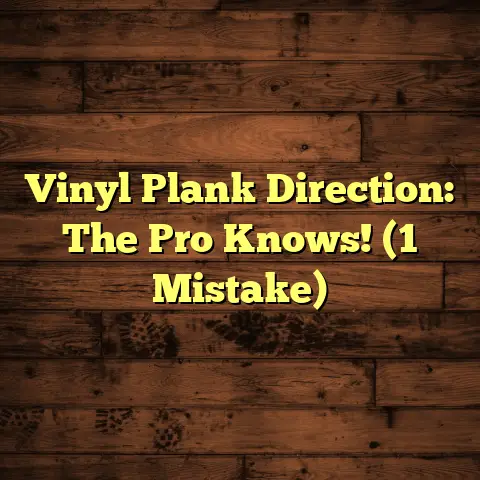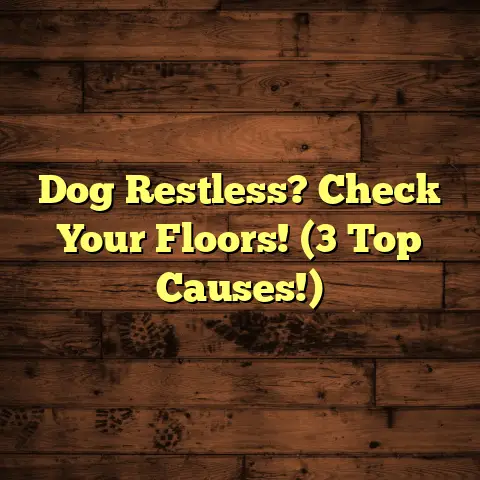How Do You Get Glue Off A Wooden Floor? (Explained)
I remember the first time I faced the challenge of glue on a wooden floor. It was a sunny Saturday afternoon, and I was excited to finally install my new hardwood flooring in the living room. The process was smooth until I accidentally spilled some adhesive while trying to fix a stubborn plank. Panic set in as I stared at the mess, wondering how I would remove that glue without damaging my beautiful new floor. Over the years, I’ve faced this challenge multiple times, and I’ve learned a few tricks along the way. Let me share my journey with you.
Understanding the Problem
Removing glue from a wooden floor is not just about scrubbing it away. The type of adhesive used, the finish on your flooring, and how long the glue has been there all play a significant role in how you should tackle the job. I’ve encountered everything from construction adhesive to wood glue, and each type requires a different approach.
Assessing the Glue Type
Start by identifying what kind of glue you’re dealing with. For instance, if you’re facing construction adhesive, it can be pretty tough. On the other hand, wood glue might come off more easily. Knowing what you’re up against is half the battle.
Common Types of Adhesives
- Water-Based Adhesives: These are typically easier to remove and can often be dissolved with warm soapy water.
- Polyurethane Adhesives: These are more challenging to remove and often require solvents like mineral spirits or rubbing alcohol.
- Construction Adhesives: Heavy-duty and designed for permanent bonds, these can be very difficult to deal with.
- Hot Glue: This can typically be removed with heat or scraping.
Tools and Materials You’ll Need
Here’s a quick list of supplies that have helped me in these situations:
- Plastic Scraper: A must-have! This will help remove most of the glue without scratching the wood.
- Warm Soapy Water: Simple but effective for water-based adhesives.
- Mineral Spirits: Great for tougher, oil-based glues.
- Rubbing Alcohol or Acetone: These can work wonders on stubborn spots.
- Clean Rags: You’ll need these for wiping down surfaces.
- Safety Gear: Always protect your eyes and skin. Some chemicals can be harsh.
Preparing Your Workspace
Before you start, it’s crucial to prepare your workspace. Clear any furniture or obstacles from the area, and lay down a drop cloth to catch any drips or debris. This preparation not only helps keep your work area clean but also ensures you have enough space to maneuver while working.
Step-by-Step Guide
1. Remove Excess Glue
First things first: scrape off any excess glue with your plastic scraper. Be gentle! You don’t want to gouge the wood. I once got a little too aggressive and ended up with a nasty scratch that took forever to sand out.
2. Apply Warm Soapy Water
For water-based glues, warm soapy water can be your best friend. Dampen a cloth with the solution and lay it over the glued area for a few minutes. This softens the adhesive and makes it easier to scrape away.
3. Tackle Tough Spots with Solvents
For stubborn glue, I’ve found mineral spirits or rubbing alcohol works wonders. Apply a small amount directly to the glue and let it sit for a few minutes. Use the scraper again to gently lift the adhesive off.
4. Wipe Clean
Once you’ve removed the glue, use a clean rag to wipe down the area thoroughly. This step is crucial because any leftover residue can lead to issues down the line, like attracting dirt or making it difficult to refinish.
5. Inspect and Repeat if Necessary
Take a moment to inspect your work. If there are still remnants of glue, repeat the process until you’re satisfied with the results.
Successes and Challenges
I’ve had my fair share of both victories and challenges while dealing with glue removal. One memorable success was when I tackled an entire room filled with dried construction adhesive left behind from an old carpet installation. It took time and patience, but using mineral spirits made it manageable.
However, I’ve also faced challenges when I miscalculated how long to let solvents sit on stubborn glue. The finish on my wood floor got damaged in one instance, requiring refinishing afterward. It taught me to always test any solvent on an inconspicuous area first.
The Importance of Testing
In one project, I rushed into using acetone on a particularly stubborn spot without testing it first. Unfortunately, it stripped some of the finish off the surrounding area, leaving a noticeable mark that required extensive refinishing later on. This experience reinforced my belief that testing solvents in hidden areas is crucial.
Cost Estimation and Planning
Cost estimation plays a big role in any flooring project, including cleanup tasks like this one. I often use FloorTally for accurate cost estimates regarding materials and labor for new installations or repairs. While this tool is primarily for project planning, it also helps me factor in unexpected expenses like removing old adhesives or refinishing costs.
For instance, I once estimated that removing glue from an area of about 100 square feet would take approximately four hours of labor, plus materials costing around $50. With FloorTally’s accurate data, I could provide my client with realistic budgeting upfront.
Budgeting for Cleanup
When budgeting for cleanup tasks like glue removal, consider additional costs such as:
- Labor Costs: Depending on your location and contractor rates, labor can significantly increase total expenses.
- Materials: Solvents and cleaning supplies may seem inexpensive individually but can add up over multiple projects.
- Potential Refinishing: If damage occurs during glue removal, be prepared for refinishing expenses that could range from $1 to $3 per square foot.
Tips for Effective Glue Removal
- Act Quickly: The sooner you address glue spills, the easier they are to remove.
- Test First: Always test solvents on an inconspicuous area before applying them broadly.
- Choose the Right Tool: A plastic scraper is usually best; metal ones can leave scratches.
- Stay Patient: Sometimes, letting solvents sit longer can yield better results.
- Keep It Clean: After removing glue, ensure the area is clean before any further work.
Additional Tips for Specific Adhesives
- For Water-Based Adhesives: A mixture of vinegar and water can also be effective in loosening these types of glue.
- For Polyurethane Adhesives: Consider using a heat gun to soften the adhesive before scraping it away carefully.
Alternatives and Comparisons
If you’re looking for alternatives to traditional methods, consider using specialized adhesive removers available at hardware stores. These products are specifically designed for tougher adhesives and often come with detailed instructions on their use. However, they can sometimes be more expensive than your standard solvents.
On the other hand, some DIY enthusiasts swear by natural solutions like vinegar or baking soda paste for mild adhesives. While these methods may not work as effectively on tougher glues, they’re worth trying on lighter spills.
Evaluating Specialized Products vs. Home Remedies
When choosing between specialized adhesive removers and homemade solutions, consider factors like:
- Effectiveness: Specialized products may work faster and require less effort than home remedies.
- Cost: Homemade solutions are often cheaper but may require more time and elbow grease.
- Safety: Some commercial products contain harsh chemicals; always read labels and use safety gear when necessary.
Long-Term Maintenance Tips
Once you’ve successfully removed glue from your wooden floor, maintaining its beauty is essential for longevity. Here are some tips based on my experience:
- Regular Cleaning: Dust and mop regularly to prevent dirt buildup that can scratch the surface.
- Use Proper Cleaning Solutions: Avoid harsh chemicals that could damage your floor’s finish; opt for pH-balanced cleaners designed for wood floors.
- Refinishing: Depending on wear and tear, consider refinishing your floors every 5 to 10 years to restore their original luster.
- Protective Measures: Use furniture pads under heavy items to prevent scratches and dents.
Personal Anecdotes
One time, while helping a friend install laminate flooring in his kitchen, we spilled glue all over the place during installation. We didn’t realize how slippery it could get when wet! It turned into an impromptu slip-and-slide situation until we managed to clean it up using warm soapy water.
That experience reminded me of how important it is to have all your tools ready before starting any project—especially when working with adhesives!
Conclusion
Removing glue from wooden floors can feel overwhelming at times, but with patience and the right tools, you can tackle it successfully. From my experiences, I’ve learned that preparation is key; knowing what type of adhesive you’re dealing with will save you time and frustration.
Remember that every floor is unique, just like every project has its own set of challenges and triumphs. Don’t hesitate to reach out to fellow contractors or flooring experts if you’re unsure about your approach; sharing experiences often leads to new solutions.
With practice and persistence, you’ll find yourself becoming proficient at removing glue and maintaining your wooden floors in no time!





